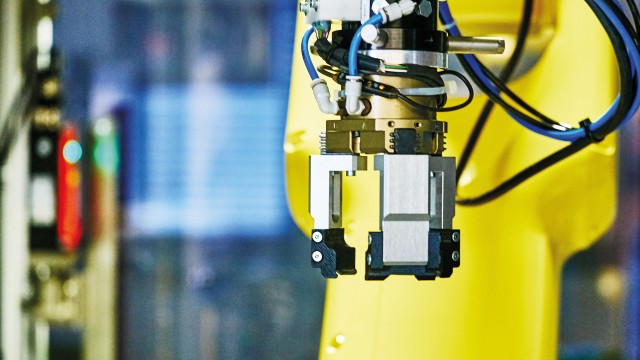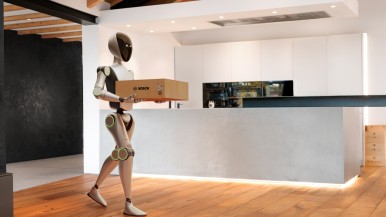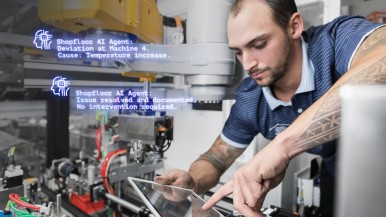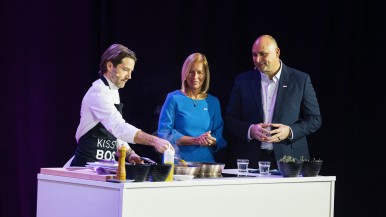Industry 4.0 is an integral part of Bosch’s corporate strategy. The company is a pioneer that is setting the pace for connected manufacturing and logistics. At Hannover Messe, Bosch is presenting product innovations, introducing research and development projects, and showcasing what the factory of the future will look like. At a booth measuring some 1,300 square meters, the company is exhibiting the factory of tomorrow, today. A large stage at the center of the booth displays no mere reproduction of the factory – this model is live and interactive. Through a combination of real exhibits and futuristic animations, the company illustrates how Industry 4.0 makes the work in manufacturing and logistics easier, more efficient, and more flexible.
Wireless power and communication
In the factory of the future, the only fixed elements are the floor, the walls, and the roof – everything else is movable and flexible. LED lighting on the smart floor indicates where autonomous transport systems will be needed next and how they get there. The necessary power comes directly and wirelessly from the factory floor. Communication among the sensors, systems, and machinery is wireless as well. Here Bosch employs the new 5G mobile communications standard, which at more than ten gigabits per second is ten times faster than the top speed currently available. 5G also significantly increases the real-time capability and the reliability with which data can be sent and received. At Hannover Messe, the company is highlighting the standard’s advantages using Bosch Rexroth’s new autonomous transport system as an example: thanks to 5G, the ActiveShuttle maintains a constant and highly reliable connection with the local manufacturing network. The result is security – both in planning and in ongoing operations.
3D printing for industrial applications
The manufacturing scenario starts with a BigRep PRO, the first 3D printer of its kind to be equipped with automation solutions from Bosch Rexroth and connected via 5G. Bosch Rexroth and BigRep, one of the leading suppliers of large-format 3D printers, are working on establishing 3D printing as industrial production technology. Automated additive manufacturing not only makes it possible to produce prototypes and models quickly and efficiently, it also makes the technology fit for serial manufacturing. According to estimates, the market for additive manufacturing could be worth some 20 billion euros.
At Hannover Messe, the BigRep printer is additionally equipped with IoT solutions from Bosch Rexroth and Bosch Connected Industry. IoT devices, software and intelligent sensors monitor all machine conditions and help to optimize product quality. This data also increases the quality of the printed components. The software is able to detect wear and errors before they lead to machine downtime, thus enhancing the printer’s availability.
ActiveShuttle sets intralogistics in motion
Intralogistics is becoming increasingly important. After all, what use is highly automated manufacturing if the materials don’t arrive at the production line on time and in the right quantities? Autonomous transport systems make intralogistics flexible and transparent. Bosch Rexroth’s new ActiveShuttle moves loads weighing up to 260 kg quickly and safely through the production facility. An integrated hub platform helps in the fully automated loading and unloading of dollies equipped with small load carriers (SLC). This means ActiveShuttle can facilitate many kinds of transport concepts, ranging from cyclical deliveries to consumption-based material supply. Even when people are present and other transport vehicles are in play, the vehicle merges effortlessly into the intralogistics environment: dynamic map updates mean that ActiveShuttle has no difficulty handling changes in its driving area.
Nexeed software for transparent value streams
In the background, the Nexeed software harmonizes, analyzes, and visualizes huge volumes of data. It is an example of how the Bosch Connected Industry operating unit, set up in 2018, is further expanding the company’s expertise in Industry 4.0 software. The demand is there: internal Bosch projects indicate that by using Nexeed, it is possible to increase productivity at individual locations by up to 25 percent while reducing stock levels by up to 30 percent. Nexeed also makes plants more flexible: manufacturers can retool machines faster and gear them up for customized production – all the way down to batch sizes of one. Nexeed also facilitates higher transparency in the intralogistics material flow and in international supply chains.
Visual inspection with artificial intelligence
Artificial intelligence offers enormous potential for improving quality and productivity in manufacturing. At Hannover Messe, Bosch is offering insights derived from its own research project, ViPAS. This visual inspection unit can inspect all sorts of components, ranging from screws and pumps to common-rail injectors – or any part its integrated robot can pick up and hold in front of its camera in the lighting dome. After comparing the images with the stored information, it classifies the parts as either OK or NOK (defective). Deep learning lets the system train itself using sample images, so ViPAS can be deployed for various visual inspection duties.
Connected hydraulics from Bosch Rexroth
Hydraulics are used to generate high forces, achieve high efficiencies, ensure safety and reliability and guarantee uniform performance over a long period of time. This also applies to industrial production. Bosch Rexroth uses the CytroBox to show how hydraulic components can be connected and integrated into the factory of the future. The sensors in the hydraulic power unit provide information on the current filter, oil or drive status. A dashboard shows maintenance staff everything they need to know about the CytroBox – from component and operating status to upcoming maintenance work and predictive maintenance analyses. Combined with a significant noise reduction to 75 dB(A), the CytroBox makes working more pleasant.





